Welcome to
the
Web-based Video Workbook
for
The Concurrent
Engineering
Video Programs Vol. 9 & 10,
on Video Tapes 9 & 10, or
on Digital Video CD-ROMs
for Engineering, Computing and
Management Students and Professionals
by
Paul G Ranky, Dr.-techn
/ PhD
Written and presented by Dr. Paul G. Ranky
and Industrial Contributors, including Mr. R. B. Syme, IBM Storage
Products Operations Manager, Mr. Gerry Edgar, Manager, Mr. Chris
Skerry, CIM Manager, Mr. Peter Neal and Mr. Mike Moulton, Managers,
IBM Havant (UK) Ltd, Mr. Robin Truman, CIM Operations Manager, GPT,
Mr. John Foster and Mr. Carlton McD Langton, Industrial Design and
Realisation, GPT-GEC Plessey Telecommunications Ltd, Mr. Paul A.
Francis, Director, International CIM Consultants, Dr. Allan Parker,
Technical Director, Mr. Mark Vaux, Mr. Mark Sealy, Mr. John Halton
and Mr. Roy Davis, Managers, Lucas Engineering & Systems Ltd, Mr.
Les Pratt, Marketing Manager, Yamazaki Machinery (UK) Ltd, Mr. Geoff
Harrington, Director, ISIS Informatics Ltd, Mr. Jim Corlett, BKT Ltd,
McDonnell Douglas Information Systems Ltd, ERT Ltd, Hitachi Seiki
(UK) Ltd and others.
Published by CIMware Ltd. UK and CIMware
USA, Inc. at http://www.cimwareukandusa.com, © Copyright by
CIMware Ltd. UK and CIMware USA, Inc., 1999 - 2000.
If you are a viewer of a legitimate copy of
the above video programs on tapes or on CDs, please feel free to view
and / or download this workbook, with its full contents, FREE
of charge, but always mention the website: http://www.cimwareukandusa.com
and the author(s) as the source!
Website:
http://www.cimwareukandusa.com
Optional on-line email support: cimware@cimwareukandusa.com
Go to Welcome Page
Please use this Workbook
together with your Video Tapes or Video CDs!
Please note, that the digital video quality
on the CD-ROMs is high and can play in full screen on a multimedia
PC, MAC or Unix machine. The video frame images inserted into this
workbook are designed to download relatively fast over the average
web-link, therefore their quality is poorer than that of the digital
videos in the CD-ROMs.
This section covers the following:
Tape/Vol. 9:
Concurrent Engineering Goals. Design for Assembly and
Manufacture. Manufacturing Early Involvement (MEI) at IBM
Tape/Vol. 10: Concurrent
Engineering and Quality (IBM)
 Additional
reading on Object Oriented Concurrent (hardware and software)
Engineering: as a new development, view the free, electronically
published R&D journal, ADAM with IT
(Advanced Design And Manufacturing with Information Technology) at
this web site, as well as enjoy the hotlinks to other web sites via
ADAM's WebCorner; both just a click
away...
Additional
reading on Object Oriented Concurrent (hardware and software)
Engineering: as a new development, view the free, electronically
published R&D journal, ADAM with IT
(Advanced Design And Manufacturing with Information Technology) at
this web site, as well as enjoy the hotlinks to other web sites via
ADAM's WebCorner; both just a click
away...
Tape/Vol.
9. Starts Here: Concurrent Engineering
Goals. Design for Assembly and Manufacture. Manufacturing Early
Involvement (MEI) at IBM
Topics covered in this program include the following:
- Concurrent Engineering Goals
- Design for Assembly and Manufacture
- Manufacturing Early Involvement (MEI) at IBM Havant
- MEI goals and critical success factors
- Competitive product plans
- World class product-process development cycle
- Plant-lab. synergy
- Availability of suitable skills
- Early awareness/knowledge
- Process and quality competitiveness analysis methods, tools
and examples
- IBM Havant industrial case studies and demonstrations
- Interactive team and/or individual exercises
When wieving this program, try to imagine that you are a member of
the concurrent engineering team. As you can see, there are several
different engineering, manufacturing, total quality, information
technology/ computing science, marketing, management and other
expertise represented in such teams.
IBM's design for manufacturing strategy and the industrial case
studies are presented by Mr. G. Edgar, Manager, IBM, Havant,
UK.
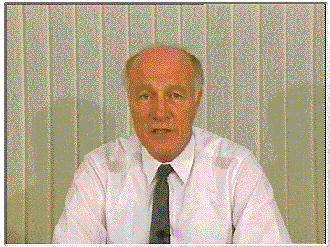

IBM's competitive product plans and the
interaction between engineering, information technology, marketing
and manufacturing. (A conceptual figure explained by Mr.
Edgar, IBM).
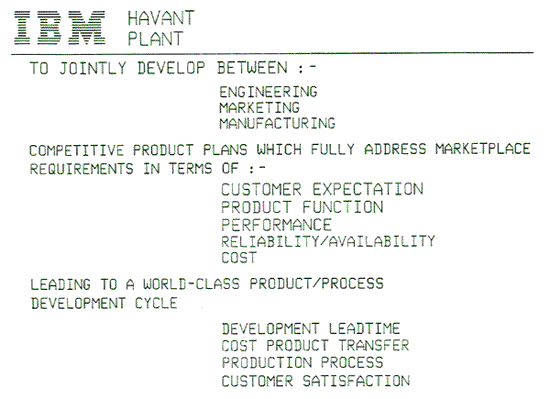
IBM's critical Manufacturing Early
Involvement success factors
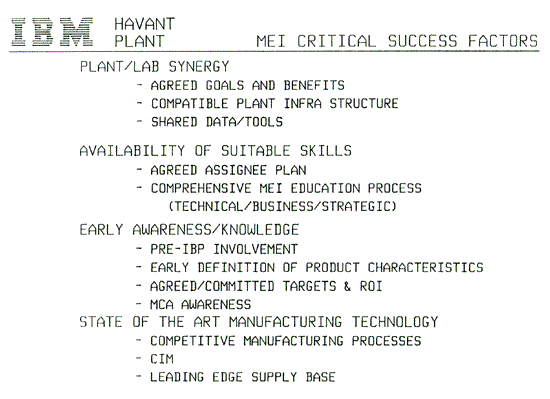
Some fundamental process interaction
issues...

IBM's concurrent engineering planning model
is revisited (in a slightly different format)...

Quality improvement and process analysis
methods and examples...(Please note,
that this figure represents a simple and useful technique that you
should learn and apply in your everyday life when trying to compare
attributes, or systems and then take decisions. Also note, that it
is in full color in the video).
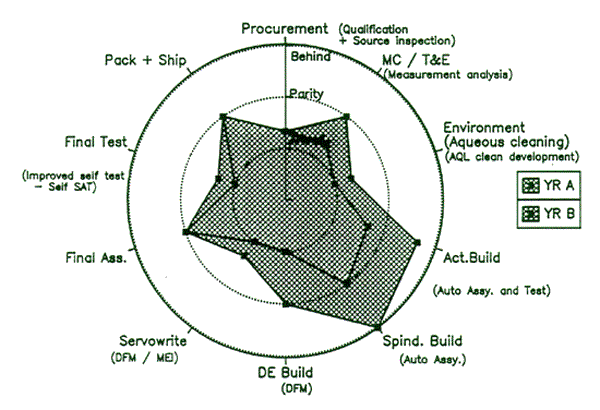
Quality and process competiveness analysis
methods and examples...(Please note,
that this figure is in full color in the video).
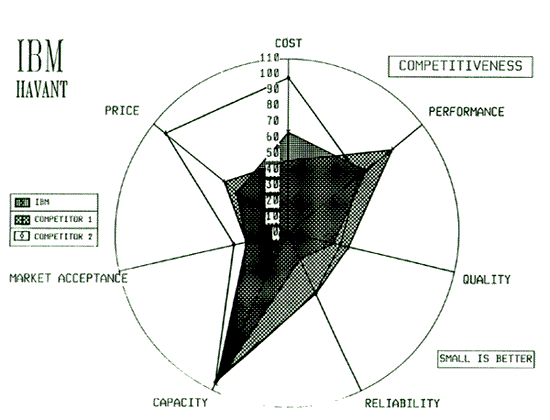
Concurrent engineering strategic penetration
issues...

As interactive team and/or individual exercises for engineering,
computing and management discuss the following:
- Describe IBM's design for manufacturing/
assembly engineering strategy. Why all this change? What are the
major driving forces? What are the tasks for engineers, computer
scientists and managers? What should management do to achieve a
collaborative effort?
- Explain IBM's competitive product plans
and the interaction between engineering, marketing and
manufacturing
- Illustrate and explain IBM's concurrent
engineering planning model. How does software development support
this model? What software packages are needed to develop and
implement such a system in your (or other) factories? What are the
management implications of helping teams to make them interested
in collaborating?
- Illustrate quality improvement and
process analysis methods and examples based on what we have
discussed in the video.
(Please note, that this discussion and the IBM case studies are
continued in Tape 10).
Jump To Top
***********************
End of Tape 9
***********************
Tape/Vol.
10. Starts Here: Concurrent Engineering
Strategy
Topics presented by by Mr. G. Edgar, Manager, IBM, Havant, UK,
covered in this program include the following:
- Concurrent Engineering Procurement Strategy at IBM
- Manufacturing Early Involvement; Procurement strategy at IBM
Havant
- Procurement analysis results at IBM Havant
- Process comparison methods and examples
- Vendor and laboratory liasion
- Concurrent Engineering management approaches
- IBM Havant industrial case studies
- Interactive team and/or individual exercises
When wieving this program, try to imagine that you are a member of
the concurrent engineering team. As you can see, there are several
different engineering, manufacturing, total quality, information
technology, marketing and other expertise represented in such
teams.
Concurrent engineering procurement strategy
at IBM... (Note, that the latest statistical data is not
shown due to confidential nature of such figures, nevertheless this
does not effect the educational value of this discussion).
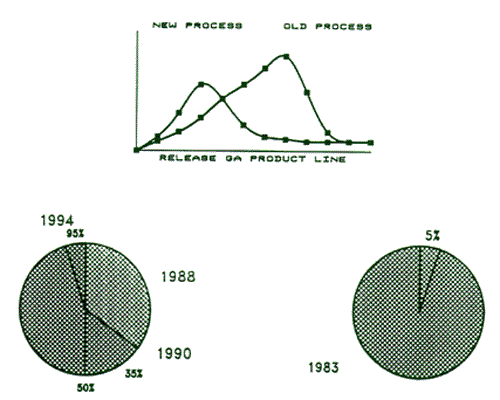
Vendor and laboratory liaison at
IBM... (Note, that the latest statistical data is not
shown due to confidential nature of such figures, nevertheless this
does not effect the educational value of this discussion).
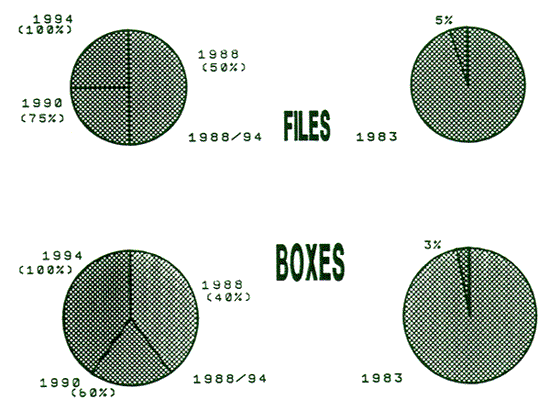
Total Quality Management (TQM)
sStrategy within a Concurrent Engineering Environment
Topics presented by by Mr. Robin Truman, Manager, GPT/ Siemens/
Plessey, UK, covered in this program include the following:
- Total Quality Management strategy within a concurrent
engineering environment
- Priorities in the West and in Japan: a comparative
assessment
- Interactive team and/or individual exercises.
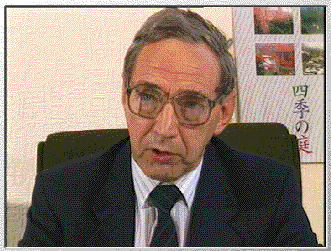
The discussion covers the following important fields with
industrial examples:
- The customer is the king...
- Priorities in the West and in Japan...
- Measure work-in-progress, not machine utilization...
- Examples in Toyota in Japan...
- Customer satisfaction is of utmost interest...
- Financial aspects in the West and in Japan...
- CIM and flexibility issues...
- People are the most flexible...(Toshiba example)
- Japanese management style...(Nissan example)
- Japanese TQM (Total Quality Management) techniques...
Note throughout the interview the engineering terminologies used
for object oriented design, and the importance of developing a
layered (integrated product and process design) information system
architecture in which objects and classes of objects enjoy
inheritance and polymorphism.
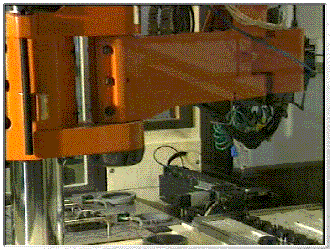
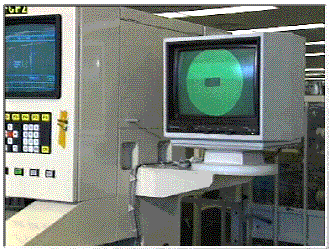
As an interactive exercise, try to
- summarize the key points, applicable to engineering, computing
and management,
- what you have learned of this tape, and
- how the discussed concepts and examples might relate to your
own work...
- Put together a plan on how to manage the collaboration and the
transition explained in this program.
Jump To Top
***********************
End of Tape 10
***********************
![]() Additional
reading on Object Oriented Concurrent (hardware and software)
Engineering: as a new development, view the free, electronically
published R&D journal, ADAM with IT
(Advanced Design And Manufacturing with Information Technology) at
this web site, as well as enjoy the hotlinks to other web sites via
ADAM's WebCorner; both just a click
away...
Additional
reading on Object Oriented Concurrent (hardware and software)
Engineering: as a new development, view the free, electronically
published R&D journal, ADAM with IT
(Advanced Design And Manufacturing with Information Technology) at
this web site, as well as enjoy the hotlinks to other web sites via
ADAM's WebCorner; both just a click
away...












